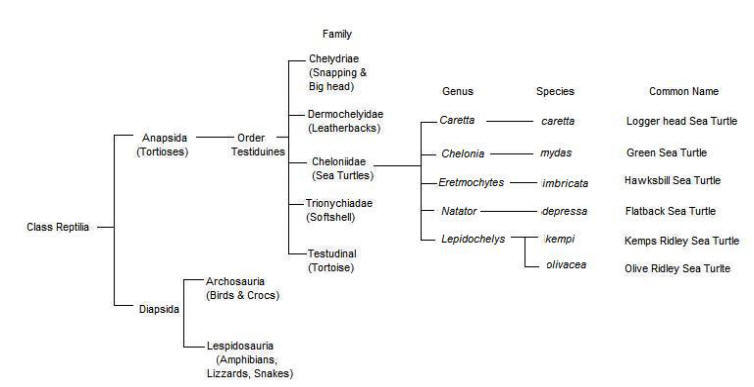
One
of my most favorite organisms is the loggerhead sea turtle (Cartetta caretta). The loggerhead sea
turtle is an endangered marine turtle species. Last summer, I found a baby
loggerhead sea turtle in the bushes and I returned it to the ocean. I like to
think that it survived the ordeal and is growing healthy and strong.
The
loggerhead sea turtle is classified as follows:
Domain: Eukarya
Kingdom: Animalia
Kingdom: Animalia
Phylum: Chordata
Class: Reptilia
Order: Testidunes
Family: Cheloniidae
Genus: Caretta
Species: caretta
Through
my research I found an evolutionary tree that suggested to me that the Chelonia mydas (Green sea turtle) may be
the loggerhead sea turtle’s closest evolutionary relative. The evolutionary
tree below shows the evolutionary relationship

According to
DNA evidence the loggerhead sea turtle is also related to the ridley and hawksbill
turtle. According to Chapter 1, What is a
Loggerhead Turtle? A Genetic Perspective by Brian W. Bowen, “ from a phylogenetic
perspective, this is an animal that diverged from the ridley and hawksbill
turtles on the order of 10 million years ago, indicating a long history of
independent evolution and adaptation.”
The loggerhead sea turtle
has no teeth but they do have a powerful jaw.
I hypothesis that the loggerhead sea turtle has a powerful jaw because
its diet includes animals with shells (crabs, mollusks, shrimp and horseshoe
crabs). Without the powerful jaws the turtle may not be able to break through
the shells and get the food that they need to survive.
The loggerhead sea turtle
lives in coastal waters. They share this environment with lobsters. Lobsters
are similar to loggerhead sea turtles because they both need to consume food to
get nutrients. Unfortunately for some lobsters, loggerhead turtles eat them
(click link below for a video of the loggerhead eating a spinny lobster.) Also
on the link you can find fun facts about loggerhead sea turtles. Did you know
that loggerhead sea turtles can reach 253 lbs, or that they can travel up to 15
miles per hour?
Video of loggerhead sea
turtle eating a spinny lobster: http://video.nationalgeographic.com/video/animals/reptiles-animals/turtles-and-tortoises/loggerhead-turtle-predation/
Another favorite marine
organisms of mine is the Florida Manatee (T.m.
latirotris). The Florida Manatee is in the same phylum as the
loggerhead sea turtle, phylum: chordata. Organisms in the phylum chordata have
a complete digestive system. This means that despite the differences in their
diets, the loggerhead sea turtle and the manatee digest their food the same way
(just like us humans – we are in the phylum chordata too).
The diet of the loggerhead
turtle not only consists of hard shelled organisms, but also of shrimp, soft
jellyfish and seaweed. If there was a dramatic change in temperature in the
upper layer of the ocean, a change that decreased the turtle’s softer food
sources, the loggerhead would be forced to eat primarily the harder shelled
organisms that live on the bottom of the ocean where the temperature might not
changed as much. If this temperature change affects the turtles food supply for
a long period of time, one evolutionary change that may occur is that future
loggerhead turtle may have an even stronger jaw and possibly teeth.
No comments:
Post a Comment